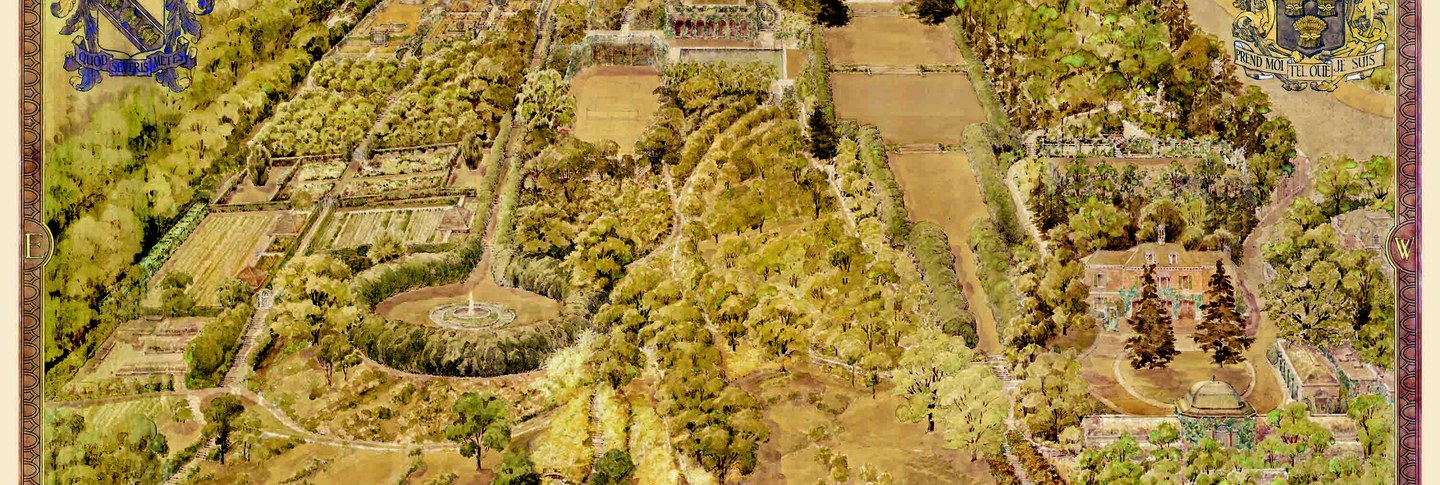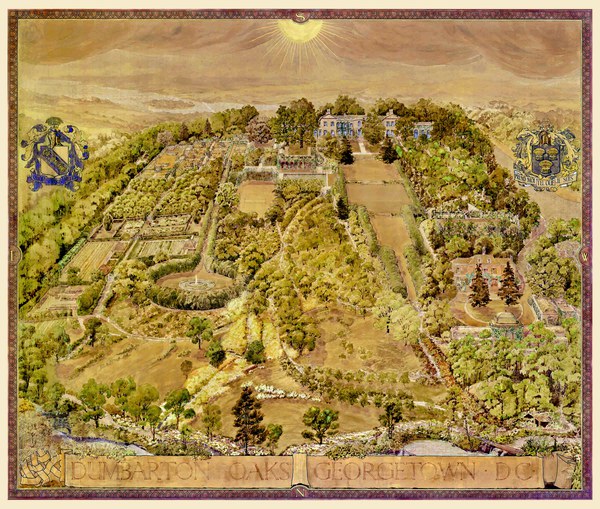The Dumbarton Oaks Garden Centennial began quietly in January 2021, when the pandemic was in full force. Like so many other institutions, we closed our doors and gates to visitors and put our exhibitions on hold. Almost immediately, we started imagining ways we could continue our programming remotely in order to launch the celebration of the one hundredth anniversary of Beatrix Farrand’s design, with an eye towards when we would welcome audiences into our galleries and gardens once again. What emerged was an exhibition model that spans the digital and analog. With such a complex landscape, we wanted to ensure that none of its significant elements and stories were overlooked. Our centennial exhibition A Century in the Gardens went live on the Dumbarton Oaks website last spring, and its in-person companion exhibit opened in our Orientation Gallery March 1.
While the website allows us to include details about the history of the site and specifics about each garden room, the gallery offers a different approach. The online and gallery components need to work in tandem, but in the gallery, we are limited by physical space and fewer opportunities to contextualize information than with the digital exhibition. To provide a picture of the gardens we needed to be thoughtful about each object. To that end, we identified a common thesis—the garden as a living and breathing work of art—around which we could build out the different elements of the narrative of a century in the gardens.
As an organic work of art, the gardens have changed throughout the last century. With the transition from private ownership by Robert and Mildred Bliss to Harvard in 1941, the gardens changed shape, accommodating their new mission as a home for the humanities serving both scholars and the public.
We began by selecting four photographs from Farrand’s tenure to illustrate the gardens’ form and function prior to Harvard’s acquisition. These black-and-white images, taken by the Stewart brothers between 1930 and 1933, are posed in conversation with a set of six newly commissioned photographs by landscape photographer Sahar Coston-Hardy taken between 2020 and 2021. Each set is arranged together, independent from the other so as not to suggest too literally a “then-and-now” relationship but rather to express the broader changes in the gardens over the last century. The photographs operate as an extension of Ernst Clegg’s 1935 watercolor of the Dumbarton Oaks Gardens in the form realized by Farrand (showing the entirety of the estate), displayed next to the Stewart images.
We also designed a timeline wall graphic with images for each decade of the last century from the 1920s to the 2020s, exhibiting significant design events. This timeline displays the change in stewardship and labor practices in the gardens and works in conjunction with the Catalogue House exhibition devoted to the labor history of the Farrand gardens and the gardeners, whose meticulous efforts allow us to continue to enjoy the space. Further underscoring the changes in design and stewardship, a monitor in the gallery plays a loop of ten Farrand design drawings working in dialogue with the photographs. Farrand’s contributions as the gardens’ designer are of paramount importance to the entirety of the centennial program, and one of her first letters to Mildred Bliss in June of 1922 is displayed near the entrance to the gallery. In the correspondence, Farrand outlines her vision for the Dumbarton Oaks Gardens as a landscape that “offers opportunities for development on so many different lines that it is difficult to know which to emphasize most strongly.” This vision would be realized over the next twenty-six years.
As the Blisses envisioned the gardens as a resource for scholarship, we have included five selections from the Rare Book Collection curated by Anatole Tchikine. These materials represent the collection of garden design, horticultural, and botanical texts started by Mildred Bliss in the late 1940s with the establishment of the Garden Library. In conjunction with the Farrand drawings on the monitor, these books help us to understand the significance of the ongoing research and academic work supported by the Dumbarton Oaks Gardens.
The exhibition provides a picture of a century in the gardens. Working with its partners in the Catalogue House and online, the centennial exhibition in the Orientation Gallery is a way for all the different elements of centennial programming to come together. Lacking the context provided on the website and having decided against lengthy wall labels, we opted to design an exhibition catalogue that is available underneath the Clegg painting (as well as digitally accessible on the website). The catalogue contains three essays on anniversaries in the garden, the landscape (and labor practices) before 1921, and the close relationship between the Blisses and Farrand. In addition to the essays, the catalogue has a more detailed timeline and six postcards of the Sahar Coston-Hardy images in the gallery.
A Century in the Gardens may have begun in quiet isolation, but with the opening of the new exhibition in February we hope we have expanded what we know and how we experience the landscape, celebrating a living, breathing work of art with an exhibition that encompasses the diversity of its different elements.
Visit the museum 2:00 p.m.–5:00 p.m., Tuesday through Sunday; admission is free, however, advance registration is required. Reserve a timed ticket here.
Gabriel Ziaukas is the postgraduate curatorial fellow for the garden centennial.

